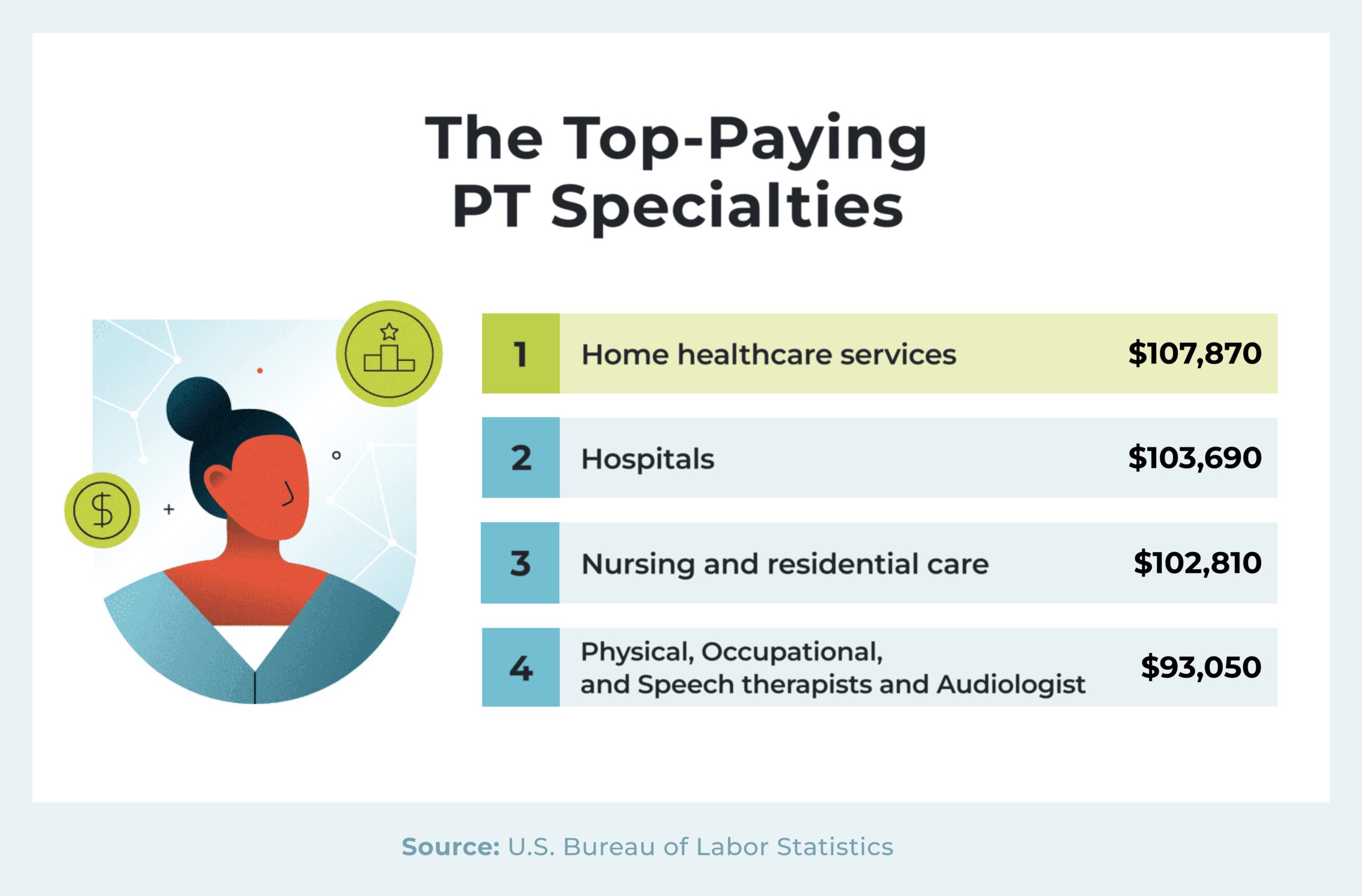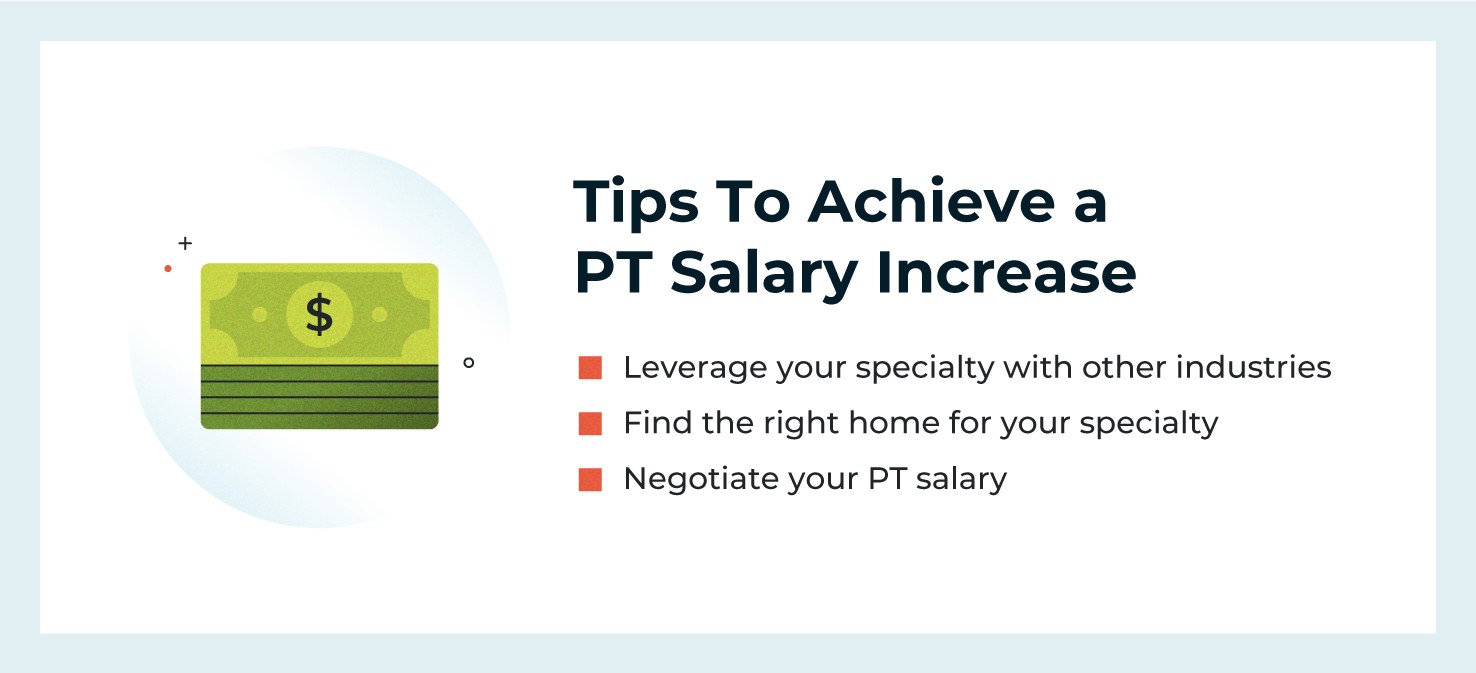How much do physical therapists make is a common question for those considering this rewarding healthcare profession, and at HOW.EDU.VN, we understand the importance of this inquiry. This comprehensive guide explores physical therapist salaries, offering insights into average earnings, influencing factors, and career advancement opportunities. We aim to provide clarity and empower aspiring and current physical therapists to make informed decisions about their careers, focusing on income potential and career path.
1. Understanding Physical Therapist Salaries
The field of physical therapy offers a fulfilling career path focused on helping individuals improve their mobility, reduce pain, and enhance their overall quality of life. A key consideration for those entering or advancing in this profession is understanding the salary landscape. Let’s delve into the factors that influence a physical therapist’s earning potential.
1.1 National Averages for Physical Therapist Salaries
According to the U.S. Bureau of Labor Statistics (BLS), the median annual wage for physical therapists in May 2023 was $99,710. This figure provides a general benchmark, but it’s important to recognize that actual earnings can vary significantly based on several factors. The top 10% of PTs earned more than $130,870 annually.
1.2 Factors Influencing Physical Therapist Salaries
Several key factors play a role in determining a physical therapist’s salary:
- Experience: As with most professions, experience is a significant driver of higher earnings in physical therapy. Entry-level PTs typically earn less than their more seasoned counterparts.
- Education and Certifications: While a Doctor of Physical Therapy (DPT) degree is the standard entry-level requirement, additional certifications and specializations can lead to increased earning potential.
- Location: Geographic location is a crucial determinant of salary. States and metropolitan areas with higher costs of living or greater demand for physical therapists tend to offer higher wages.
- Work Setting: The type of facility where a physical therapist works also impacts their salary. For example, PTs working in home healthcare settings may earn more than those in private clinics.
- Specialization: Certain areas of specialization within physical therapy, such as sports medicine or neurological rehabilitation, may command higher salaries due to the specialized skills and knowledge required.
2. Physical Therapist Salaries by State
Geographic location significantly impacts earning potential in physical therapy. Here’s a snapshot of average annual salaries for physical therapists across different states:
| State | Annual Mean Salary Range (2023) |
|---|---|
| California | $100,810 – $114,270 |
| Nevada | $100,810 – $114,270 |
| New Jersey | $100,810 – $114,270 |
| Alaska | $100,810 – $114,270 |
| Connecticut | $100,810 – $114,270 |
| New York | $100,810 – $114,270 |
| Texas | $100,810 – $114,270 |
| Washington | $100,810 – $114,270 |
| Hawaii | $100,810 – $114,270 |
| Illinois | $100,810 – $114,270 |
| Delaware | $100,810 – $114,270 |
| Maryland | $100,810 – $114,270 |
| Washington, D.C. | $100,810 – $114,270 |
| Arizona | $96,860 – $100,310 |
| Pennsylvania | $96,860 – $100,310 |
| Alabama | $96,860 – $100,310 |
| Virginia | $96,860 – $100,310 |
| Georgia | $96,860 – $100,310 |
| Ohio | $96,860 – $100,310 |
| Minnesota | $96,860 – $100,310 |
| Utah | $96,860 – $100,310 |
| Colorado | $96,860 – $100,310 |
| Oregon | $96,860 – $100,310 |
| Louisiana | $96,860 – $100,310 |
| Massachusetts | $96,860 – $100,310 |
| New Mexico | $96,860 – $100,310 |
| Mississippi | $94,130 – $96,760 |
| Rhode Island | $94,130 – $96,760 |
| Wisconsin | $94,130 – $96,760 |
| Vermont | $94,130 – $96,760 |
| West Virginia | $94,130 – $96,760 |
| Indiana | $94,130 – $96,760 |
| North Carolina | $94,130 – $96,760 |
| Michigan | $94,130 – $96,760 |
| South Carolina | $94,130 – $96,760 |
| Florida | $94,130 – $96,760 |
| Tennessee | $94,130 – $96,760 |
| Oklahoma | $94,130 – $96,760 |
| New Hampshire | $94,130 – $96,760 |
| Wyoming | $52,690 – $93,780 |
| Missouri | $52,690 – $93,780 |
| Idaho | $52,690 – $93,780 |
| Nebraska | $52,690 – $93,780 |
| Kansas | $52,690 – $93,780 |
| Iowa | $52,690 – $93,780 |
| South Dakota | $52,690 – $93,780 |
| Maine | $52,690 – $93,780 |
| Kentucky | $52,690 – $93,780 |
| Montana | $52,690 – $93,780 |
| North Dakota | $52,690 – $93,780 |
| Puerto Rico | $52,690 – $93,780 |



It’s crucial to note that these are average figures and can fluctuate based on local market conditions, demand, and other factors.
3. Physical Therapist Salaries by Work Setting
The setting in which a physical therapist practices also influences their earning potential. Here’s a breakdown of average salaries by work environment:
- Home Healthcare Services: $107,870
- Hospitals: $103,690
- Nursing and Residential Care Facilities: $102,810
- Offices of Physical, Occupational, and Speech Therapists, and Audiologists: $93,050
These figures suggest that home healthcare and hospital settings tend to offer higher compensation for physical therapists.
4. Specialization and its Impact on Physical Therapist Salaries
The American Physical Therapy Association (APTA) offers specialist certifications in various areas of physical therapy. Obtaining a specialist certification can lead to increased job opportunities and higher salaries. Here are some common areas of specialization and their potential impact on earnings:
- Orthopedic Physical Therapy: Focuses on musculoskeletal conditions and injuries.
- Sports Physical Therapy: Specializes in treating athletes and sports-related injuries.
- Neurologic Physical Therapy: Addresses conditions affecting the nervous system, such as stroke or spinal cord injury.
- Geriatric Physical Therapy: Concentrates on the unique needs of older adults.
- Pediatric Physical Therapy: Works with infants, children, and adolescents with developmental or physical challenges.
- Cardiovascular and Pulmonary Physical Therapy: Focuses on patients with heart and lung conditions.
- Clinical Electrophysiology: Involves the use of electrical modalities for diagnosis and treatment.
- Women’s Health Physical Therapy: Addresses conditions specific to women, such as pelvic floor dysfunction.
- Oncology Physical Therapy: Assists cancer patients with rehabilitation and recovery.
- Wound Management: Specializes in treating chronic wounds and promoting healing.
While specific salary data for each specialization is not readily available, pursuing a specialty certification can enhance a physical therapist’s expertise, making them more attractive to employers and potentially leading to higher compensation.
5. Strategies to Increase Your Physical Therapist Salary
If you’re looking to boost your earning potential as a physical therapist, consider the following strategies:
5.1 Pursue Advanced Education and Certifications
Earning a specialty certification from the APTA can demonstrate your expertise in a particular area of physical therapy and make you a more valuable asset to employers. Additionally, consider pursuing a post-professional degree, such as a Doctor of Science (DSc) or a PhD, to enhance your research and clinical skills.
5.2 Gain Experience and Expertise
As you gain experience in the field, seek out opportunities to develop specialized skills and knowledge. Attend continuing education courses, workshops, and conferences to stay up-to-date on the latest advancements in physical therapy.
5.3 Consider a Travel Physical Therapy Assignment
Travel physical therapy offers the opportunity to work in various locations across the country while earning a competitive salary and benefits package. Travel PTs often receive higher compensation to offset the costs of travel and temporary housing.
5.4 Negotiate Your Salary
When accepting a new job or negotiating a raise, research average salaries for physical therapists in your area and use this information to support your case. Highlight your qualifications, experience, and any additional value you bring to the role.
5.5 Consider a Career in Academia or Research
If you have a passion for teaching or research, consider a career in academia or research. These roles may offer lower salaries than clinical practice, but they can provide opportunities for professional growth and development.
5.6 Open Your Own Practice
Starting your own physical therapy practice can be a rewarding but challenging endeavor. As a business owner, you have the potential to earn a higher income than you would as an employee, but you also assume the risks and responsibilities of running a business.
6. Leveraging Speciality with Other Industries
To aim for a higher physical therapist salary, you can get ahead by combining management with PT practice. Consider the following roles and average annual salaries:
| Role | Average Annual Salary |
|---|---|
| Medical Scientist | $100,890 |
Are you interested in a career in research and health sciences? The average annual salary for a medical scientist is $100,890.
7. Finding the Right Home for Your Speciality
Another way to maximize your PT salary is geographic targeting. PT salaries vary by city and state and do not always align with the cost of living.
Look at nationwide average salaries reported by the U.S. Bureau of Labor Statistics and follow up with cost-of-living comparisons to identify prime opportunities, then investigate specialties to evaluate different types of physical therapists and salaries in those locations.
8. The Role of HOW.EDU.VN in Advancing Your Physical Therapy Career
At HOW.EDU.VN, we recognize the challenges and aspirations of physical therapists at all stages of their careers. We’ve created a platform to connect you with leading experts and provide personalized guidance to help you achieve your professional goals.
8.1 Access Expert Advice from Top Professionals
Our team of experienced doctors and specialists offers insights on career advancement, salary negotiation, and specialization options.
8.2 Tailored Solutions for Your Unique Needs
We provide personalized consultations to address your specific questions and concerns, ensuring you receive the most relevant and effective advice.
8.3 Stay Ahead of the Curve with the Latest Industry Trends
We keep you updated on the latest developments in physical therapy, including emerging specialties and innovative treatment approaches.
9. The Benefits of Becoming a Physical Therapist
There are many benefits and reasons to become a physical therapist, including:
- The ability to help others: PTs have many qualities that make them great at supporting others. Whether it’s helping patients recover from injuries, regain mobility, manage chronic conditions or improve their physical well-being, PTs can contribute to individuals’ overall quality of life.
- Varied work environments: PTs choose their work settings, including home health agencies, nursing homes, private clinics, hospitals, rehabilitation centers and sports facilities. This diversity allows for a range of experiences and the ability to choose something that aligns with your interests and career goals.
- Growth opportunities: PT offers numerous opportunities for professional advancement. Pursue specialist certifications, take on leadership roles, engage in research or academia or start a private practice.
- Collaboration and teamwork: PTs typically operate as part of a multidisciplinary team, collaborating with physicians, nurses, occupational therapists, speech therapists and other healthcare professionals. This teamwork provides the opportunity to exchange ideas and deliver comprehensive patient care.
- Competitive salary: PTs typically enjoy a competitive salary as demand continues to increase—the BLS projects a 15% employment growth for physical therapists between 2022 and 2032.
While how much a physical therapist makes can vary depending on experience, specialty, location and setting, the profession generally offers a respectable income level.
10. Addressing Common Concerns and Misconceptions
Before pursuing a career in physical therapy, it’s important to address some common concerns and misconceptions:
10.1 Is Physical Therapy a Stressful Profession?
Like any healthcare profession, physical therapy can be demanding and stressful at times. However, the ability to make a positive impact on patients’ lives and help them achieve their goals can be incredibly rewarding.
10.2 Is There a Risk of Burnout in Physical Therapy?
Burnout is a risk in any profession, but there are steps you can take to prevent it. Prioritize self-care, set boundaries, and seek support from colleagues and mentors.
10.3 Is Physical Therapy a Good Career Choice for Introverts?
While physical therapy requires strong communication and interpersonal skills, it can be a good fit for introverts who enjoy working one-on-one with patients and developing meaningful relationships.
11. Physical Therapist Salary FAQs
11.1 What Do the Highest 10% of PTs Earn?
According to the BLS, the top 10% of PTs earn about $130,870 annually. PT salary averages do not factor in location, years of experience, facility type, credentials or specialties.
11.2 What is the Highest Paid Physical Therapist?
PTs who work in the home healthcare service industry are the types of physical therapists with the highest salary. As of May 2023, the annual median salary for U.S.-based physical therapists working in home healthcare services was $107,870.
11.3 How can I increase my earning potential as a physical therapist?
- Specialize: Obtain certifications in high-demand areas like sports medicine or geriatrics.
- Relocate: Consider working in states or metropolitan areas with higher average salaries.
- Gain Experience: Aim for senior positions or management roles within your organization.
- Negotiate: Always negotiate your salary based on your skills, experience, and market rates.
- Further Education: Get a post-professional degree to enhance your expertise.
11.4 Is a Doctor of Physical Therapy (DPT) degree worth the investment?
Yes, a DPT degree is essential for practicing physical therapy and offers a solid return on investment due to the profession’s earning potential and job satisfaction.
11.5 What are the common benefits offered to physical therapists?
- Health insurance
- Paid time off
- Continuing education allowances
- Retirement plans
- Professional liability insurance
11.6 Are there opportunities for remote work in physical therapy?
While most physical therapy roles require in-person interaction, telehealth and remote consultations are becoming increasingly common, offering some opportunities for remote work.
11.7 What is the job outlook for physical therapists?
The job outlook for physical therapists is excellent, with a projected growth rate of 15% from 2022 to 2032, much faster than the average for all occupations.
11.8 How does the cost of living affect physical therapist salaries?
Areas with higher costs of living often offer higher salaries to compensate for the increased expenses. However, it’s important to consider the overall quality of life and affordability when choosing a location.
11.9 What skills are essential for a successful physical therapist?
- Strong communication and interpersonal skills
- Empathy and compassion
- Critical thinking and problem-solving abilities
- Manual therapy skills
- Knowledge of anatomy and physiology
11.10 How can I stay up-to-date with the latest trends and advancements in physical therapy?
- Attend conferences and workshops
- Read professional journals and publications
- Join professional organizations like the APTA
- Network with colleagues and mentors
12. Take the Next Step in Your Physical Therapy Career with HOW.EDU.VN
Ready to take your physical therapy career to the next level? Contact HOW.EDU.VN today to connect with our team of expert doctors and specialists. We’ll provide personalized guidance and support to help you achieve your professional goals.
- Address: 456 Expertise Plaza, Consult City, CA 90210, United States
- WhatsApp: +1 (310) 555-1212
- Website: HOW.EDU.VN
Don’t wait any longer to unlock your full potential in physical therapy. Contact how.edu.vn today and let us help you chart a course for success.
13. Resources and Further Reading
- American Physical Therapy Association (APTA): www.apta.org
- U.S. Bureau of Labor Statistics (BLS): www.bls.gov
- PayScale: www.payscale.com
These resources offer valuable information on physical therapy salaries, career paths, and industry trends.
Please be aware that the accuracy, completeness, and reliability of the data may vary due to its voluntary nature and limited scope. While efforts are made to maintain the data’s accuracy, we cannot guarantee its absolute correctness or currency.
Salary data may not reflect starting pay for recent graduates.